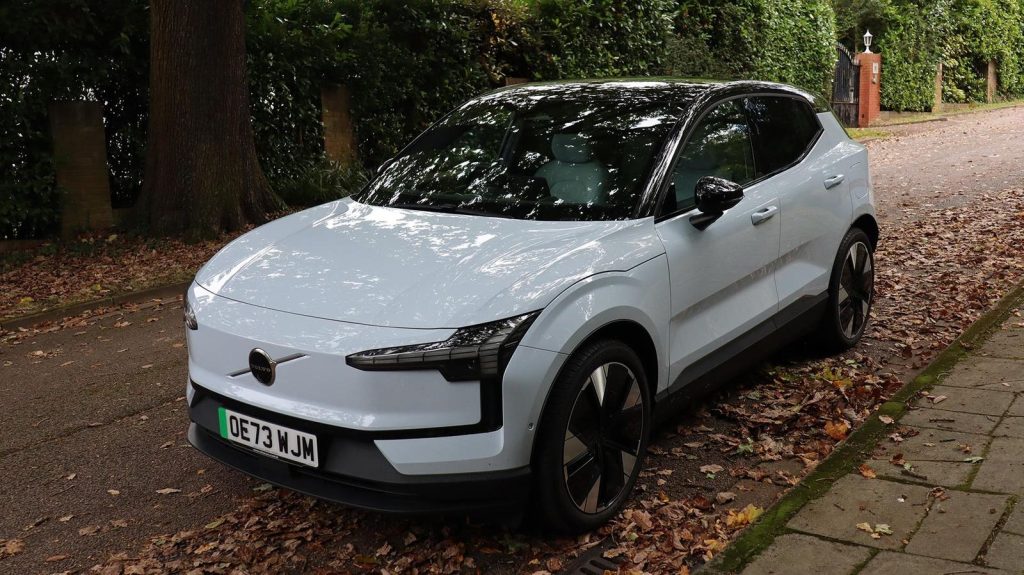The quest for more affordable EVs continues. Volvo hasn’t normally been associated with budget vehicles, but since the company became part of massive Chinese automaker Geely, its focus has changed. Enter the EX30, a small SUV that brings the entry price for an electric Volvo down to a new level. But is the cost low enough?
The EX30 sits in the SUV category because it rides a little higher than a standard compact hatchback, but it should really be considered in the latter class. Although the front diverges from the typically angular Volvo look, the rear is reminiscent of the larger XC40 and C40 SUVs. For those who remember the original Honda HR-V, the EX30 is very much that kind of vehicle – not really meant for non-tarmac road usage.
Volvo EX30: Motor, Battery and Trim Choices
There are three drivetrain choices. The basic one pairs a 268hp motor driving the rear wheels with a 51kWh (gross) battery pack. You can also specify this motor with a larger 69kWh (gross) Extended Range pack. Top of the pile is a dual-motor setup offering a combined 422hp alongside the same Extended Range battery.
There are three trims to choose from. Core is only available with a single-motor drivetrain. Plus can have all three. Ultra is only available with the Extended Range battery. This being a Volvo, all versions are packed with safety technology, including adaptive cruise control that offers traffic jam stop and go. The driver assistance is a bit more advanced with the Plus, which also adds a powered tailgate plus heated front seats and steering wheel. Ultra introduces a panoramic sunroof, 360-degree parking camera, 22kW AC charging and a heat pump.
The interior of the EX30 is decidedly “modern”. It takes quite a few cues from the Tesla Model 3 (pre-Highland) and Y. There is no dashboard instrumentation, just a central screen, which in this case is portrait in orientation with a 12.3in diagonal. This means you will need to look to the center to see how fast you’re going. This approach caused a few raised eyebrows when the Model 3 first came out, but most owners have subsequently found it’s a perfectly workable solution.
The touch buttons on the steering wheel are a bit fiddly, but at least you get a real physical stalk to operate the windscreen wiper speed, even though it doubles for lights and indicators. The stalk on the right operates drive, reverse and park, just like the pre-Highland Tesla Model 3 or a Mercedes. Air conditioning is operated via the infotainment panel. The control icons are permanently visible and reasonably large, but there’s no discrete button for windscreen demisting, so you need to call up the climate screen first.
Volvo has now gone all in with Google as supplier of its infotainment software. All cars get four years of live services. Navigation comes from Google Maps, and the Google Play store is available to download apps, such as games or My Talking Tom Friends. Despite having Google Maps available, you can also use Waze directly. Spotify comes as standard, too, although you must supply your own account. Streaming YouTube is available. Overall, it’s an advanced connected system.
Although the interior design is very minimal, there are some nice touches. The sliding panel converts the area in front of the central armrest into two cupholders. Beneath that is a small compartment and two spaces for smartphones, although only one offers wireless charging. Bizarrely, there’s no glovebox in the dashboard ahead of the front passenger. But there is an opening compartment below the infotainment screen.
Volvo EX30: Range and Performance, But Limited Rear Space
Although the battery options are adequate, they’re not huge in the current market. The 51kWh battery delivers a WLTP range of 209 miles while the 69kWh battery provides 294 miles with a single motor and 279 miles with dual motors. However, while driving the dual-motor car I only achieved an average of 2.73 miles per kWh. With the Extended Range battery’s usable capacity of 64kWh, that would mean a real-world range of just 175 miles.
There’s DC charging with the small battery up to 134kW, and up to 153kW with the Extended Range version. That means the former can recharge from 10 to 80% in 27 minutes, and this drops to 25 minutes with the latter. So you will need to charge every couple of hours on a long journey, making the EX30 not quite a mile-munching king. But it will still be adequate for driving between cities as well as within them.
Probably the biggest downside with the EX30 is the amount of room in the back, both for passengers and cargo. An average-sized man sitting behind another average-sized man in the driving seat will have their knees almost touching the seat back in front, although they will still have plenty of headroom.
Luggage capacity is also more compact hatchback than SUV. With the rear seats up, you get 318 liters – less than a Volkswagen ID.3. The rear seats drop forward with a 60/40 split, and there are some nice features like clips that retain the safety belts, so they won’t get caught when you put the seats back up. But while the luggage area is flat, it is only 914 liters, less than the ID.3 and even a Nissan Leaf. The EX30 can at least tow – up to 1,000kg with the small battery, and up to 1,600kg with the Extended Range one. There’s also a very small frunk, but just enough for a charging cable or your packed lunch.
So far, so unexceptional. But now we come to the EX30’s performance. Whichever version of this car you go for, it’s quick. Even the basic single-motor EX30 with the smaller battery can hit 62mph in 5.7 seconds. Surprisingly, the single motor with the larger Extended Range battery is faster, taking just 5.3 seconds to reach 62mph. These are hot hatch figures, but the 422hp dual-motor EX30 goes much further, taking a borderline insane 3.6 seconds. That’s getting close to a Tesla Model 3 Performance.
The suspension setup also doesn’t match the acceleration. This is a fast EV but not a hot hatch. I’ve driven the dual motor version around the Millbrook hill test track at pace. It’s fun and capable of being chucked gleefully into corners, but not in the same way as you might with a Golf R. The dual motor car also has a slight steering pull if you accelerate when turning.
But as quick transport around urban areas and country A roads, the EX30 is superb. The acceleration the dual-motor car is capable of will allow you to flit around the city (20mph speed limits permitting) and overtake slow traffic on a country road rapidly and safely. Motorway driving is comfortable too, although as mentioned above you will need to stop for a charge every couple of hours.
Volvo EX30: Worth The Money?
When Volvo’s first all-electric SUV, the XC40 Recharge Twin, arrived in 2021, it started close to £50,000 ($66,000). The good news is that the EX30 comes in at a much lower level. The base Core spec starts at £32,850 ($43,000) and the Plus at £34,400 ($45,000), although the Ultra is a bigger step up at £42,350 ($56,000). Even with the dual-motor powertrain, the Ultra is still below £45,000 ($59,000). Unlike most German brands, Volvo also includes almost everything in the trim, with very few optional extras. Even the paint and interior choices are free.
That doesn’t make the EX30 cheap, but it’s much more mainstream in price. It will face some stiff competition, for example from the Kia EV3, which promises similar quality, lower performance, but more range for the money. Nevertheless, there was a fair bit of interest in the EX30 when it was announced. In practice, with the caveats of rear space and merely mediocre range, it lives up to the expectations. It’s incredibly fast and packed with solid technology, making it well worth considering if you’re looking for a small family electric car primarily for local use.
Read the full article here










